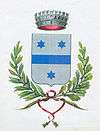San Michele al Tagliamento
| San Michele al Tagliamento | ||
|---|---|---|
| Comune | ||
| Comune di San Michele al Tagliamento | ||
| ||
 San Michele al Tagliamento Location of San Michele al Tagliamento in Italy | ||
| Coordinates: 45°45′49″N 12°59′43″E / 45.76361°N 12.99528°E | ||
| Country | Italy | |
| Region | Veneto | |
| Province / Metropolitan city | Venice (VE) | |
| Frazioni | Bevazzana, Bibione, Cesarolo, Pozzi, San Giorgio al Tagliamento, III Bacino, Villanova-Malafesta Località: Marinella, San Filippo | |
| Government | ||
| • Mayor | Pasqualino Codognotto | |
| Area | ||
| • Total | 112.3 km2 (43.4 sq mi) | |
| Elevation | 7 m (23 ft) | |
| Population (31 January 2009)[1] | ||
| • Total | 11,908 | |
| • Density | 110/km2 (270/sq mi) | |
| Demonym(s) | Sanmichelini | |
| Time zone | CET (UTC+1) | |
| • Summer (DST) | CEST (UTC+2) | |
| Postal code | 30028 | |
| Dialing code | 0431 | |
| Patron saint | Madonna della Salute | |
| Saint day | 21 November | |
| Website | Official website | |
San Michele al Tagliamento is an Italian Municipality with 11,930 inhabitants [2] in the province of Venice, Veneto, Italy.
SS14, one of the main State Highways (Italy), passes through the commune, whose frazione of Bibione is a popular tourist resort.
Bibione resort has a range of canine facilities, including showers, beds and leashes, as well as Pluto Beach, which is especially for dogs. Together with other northeastern Italian towns by the sea, Bibione is one of the most common tourist destinations for Germans, Austrians and Eastern Europeans. [3]
Location and facts
The neighboring municipalities are Caorle, Fossalta di Portogruaro, Latisana (UD), Lignano Sabbiadoro (UD), Morsano al Tagliamento (PN), Portogruaro, Ronchis (UD) and Varmo (UD).
History
The first traces of human settlement date back to the 4th and 3rd centuries BC, when the area (now part of the municipality of San Michele al Tagliamento) was populated by the Adriatic Veneti.
From 181 AC onward, the Romans' colonization marked the beginning of the land reclamation and agricultural development of the entire area. Since the end of the 18th century, archaeological excavations have led to the discovery of black and white mosaic floors, copper coins, glass fragments and pottery, which can be traced back to the Roman imperial period.
Bibione
Bibione is a middle-sized district of about 3,000 inhabitants. It is a seaside resort, particularly popular among German and Austrian tourists. In the last few years, the number of visitors from the Netherlands, Belgium, Czech Republic, Poland, Hungary and Ireland has risen significantly and this trend will probably continue.
The city offers around 100,000 beds, whether in hotels, holiday apartments or on campsites. Bibione is mostly visited between May and September, since this is the most suitable period to bathe. Many shops and beach facilities are open only during the summer season. Traditionally, a weekly market takes place every Tuesday on the square in front of the funfair. Here you can find both towels and food.
Location
Bibione is situated between the Adriatic and the river Tagliamento. Given the soil consistency and on the basis of some excavations, it can be assumed that Bibione originally consisted of a small group of islands. These were connected to the mainland and the lagoon by a narrow stretch of land, mentioned in several Roman and medieval documents as insulae bibioni or Bibiones.
History
After the fall of the Roman Empire and the spread of Christianity, Bibione was given to the bishops of Concordia. Over the following centuries, the islands were neglected and pinewoods spread over the whole area. The actual land reclamation started at the beginning of the 20th century, when drainage canals and embankments were built. When the works ended, around 1950, Bibione was left with its pine forests and its sandy beach. In the following years, the first holiday accommodations were built and Bibione became a tourist resort.
Present situation
Tourists come largely from Germany and Austria, but also from Italy, Eastern European countries and other parts of Europe (depending on the season and on the town district preferred) to spend their holidays on the flat sandy beaches of Bibione. The cityscape is characterized by the numerous hotels, guest houses and campsites, which provide a total number of beds that is forty times higher than the number of inhabitants.
Bibione is especially popular among families, as childcare and entertaining activities are offered both in the hotels and on the beach. In the "Lido dei Pini", a 300 meter long section of the beach has been equipped especially for dogs and their owners. This part of the beach is called "Lido del Faro". All kinds of water sports (windsurfing, kayak, sailing, sea excursions) are also offered. At night, pubs and clubs complete the range of free-time activities.
Bibione is divided into different areas: Lido dei Pini, Bibione Pineda, Bibione Spiaggia and Lido del Sole. In summer 2014, a smoking ban was imposed on the area between the shore and the first row of beach umbrellas and Bibione thus became Italy´s first smoke-free beach. However, smoking is still allowed in the area where beach umbrellas are for rent.[4]
Sources
- ↑ All demographics and other statistics from the Italian statistical institute (Istat)
- ↑ "The National Institute of Statistics (Istat)". 2016.
- ↑ Beach
- ↑ "Bibione (Venedig), Erster Rauchfreier Strand Italiens" (in German). www.bibione.com. Retrieved 2015-08-11.
External links
| Wikimedia Commons has media related to Category:San Michele al Tagliamento. |
- everything about San Michele al Tagliamento portal with all type of info about San Michele al Tagliamento
- Bibione - tourist information
